Abstract
This paper discusses problems associated with water-based drilling fluids used for drilling formations with abnormally high pressure. The available solutions are suitable for a narrow range of applications, especially when weighted muds should be used. This paper reviews the experience of searching and developing a new type of drilling mud based on saturated brines. With the referenced papers as the basis, the authors developed compositions of such brine-based drilling muds. A distinctive feature of the considered compositions is the absence of barite, which is often used as a weighting agent. The paper presents a methodology for creating and investigating the proposed drilling fluids. The rheological properties and thermal stability of the muds at various temperatures were studied. The results show that proposed drilling fluids can be efficiently used for drilling formations with abnormally high pressure. It is assumed that the developed muds have greater versatility than analogues.
1. Introduction
Drilling in difficult geological conditions can be challenging; hence, it is necessary to consider various approaches to improve drilling efficiency [1]. With increasing depth of operations, a higher density of the drilling muds is required. Obtaining high-density muds is most often achieved by adding barite in significant quantities (≥500 kg/m3) [2,3].
One of the challenges is to keep barite particles suspended. The longer the mud is in a static state, the more barite particles are deposited, which leads to problems such as pipe sticking or hydraulic fracturing [4,5]. Increasing the rheological parameters to keep the barite particles suspended in the mud usually results in increased hydrodynamic loads on the wellbore and increased equivalent circulating density (ECD) of the drilling mud [6,7]. In addition, barite leads to the formation of a filter cake with poor qualities that can cause pipe sticking. Creating drilling fluids for drilling through a pay zone requires a deep understanding of the reservoir [8,9]. Damage mechanisms of the productive formation during drilling include fine-solids migration, clay swelling, incompatibility of the drilling mud with formation fluid, and the use of formation-damaging reagents that can reduce average formation permeability, resulting in lower flow rates [10,11,12]. Barite cannot be dissolved in acid and this characteristic leads to a decline in reservoir properties when it is filtered into the pay zone [13].
The existing situation has led to the search for and investigation of new ways to design weighted drilling muds. Weighting with salt has become such a method [14,15,16]. Increasing the density of drilling fluids by salts is more effective when using water-based muds (WBMs).
WBMs are used to drill approximately 80% of all wells. The base fluid may be fresh water, seawater or brine [17,18,19]. The type of fluid depends on the expected conditions in the well or the specific interval to be drilled. For example, the upper intervals are usually drilled with a low-density freshwater or seawater-based mud with few reagents. During drilling operations, natural clays are produced in such muds. Bentonite or attapulgite may also be intentionally added to control mud loss or to enhance wellbore cleaning. After running and cementing the surface casing, the drilling operator often continues to drill with the WBM unless conditions in the well require replacing it with an oil-based or synthetic-based mud. For abnormally high pressure, it is reasonable to use muds based on brine saturated with heavy salts (bromides or formates) [20,21,22].
The WBMs fall into two broad categories: non-dispersed and dispersed. Simple water–gel systems used for drilling of upper intervals in the well are non-dispersed, unlike many advanced polymer systems with low or zero bentonite content [23,24]. Natural clays that enter undispersed systems during drilling are subjected to dissolving, encapsulation and/or flocculation. The low-colloid solid phase is encapsulated and flocculated for more efficient removal at the surface, which reduces the need for dilution [25,26,27].
Dispersed systems are treated with chemical dispersants and designed to deflocculate clay particles to be able to control the rheology of high-density drilling fluids. Commonly used dispersant additives include lignosulfonates, lignins and tannins. Dispersant systems typically require the addition of caustic soda (NaOH) to maintain a pH of 10 to 11. Commonly used dispersed drilling fluids contain lime and other cationic systems. However, a dispersed system containing solids can significantly reduce the rate of penetration and contribute to wellbore damage.
Drilling fluids based on salt water are often used to prevent dispersion in shale formations and for drilling in salt formations. They are also known to prevent the formation of hydrates that can accumulate around subsea wellheads and x-mas trees, plugging pipelines and interfering with critical operations. High-density brines, such as calcium chloride, calcium bromide, zinc bromide, potassium and cesium formate, can be included in the formulation of low-solids and no-solids systems [28,29,30].
The solids content of low-solids drilling fluids should not exceed 6–10%. Low-solids muds typically use polymer reagents as a thickener or bentonite filler. These muds are non-dispersed. The main advantage of the drilling fluids with low solids content is their significantly increased rate of penetration [3,6,31].
Potassium chloride is added to drilling fluids to stabilize water-sensitive clays through the inhibition created by potassium ions. Due to the inhibiting abilities of solutions that contain potassium chloride, clay hydration is reduced to a minimum, leading to a reduction in cavernosity, less sealing of the bit and stabilizer, less clay caving, and the preservation of reservoir properties [12,32,33]. Potassium chloride salt is used as the main source of potassium ions in the muds. The system acts most effectively in the presence of polymers providing encapsulation. For this purpose, either polyanionic cellulose or partially hydrolyzed polyacrylamide are used [17].
These polymers encapsulate the drilled-out particles and opened clays, limiting their interaction with water. Due to the fact that clays have different degrees of sensitivity to water, different KCl concentrations are required to inhibit different types of clays [17,34].
The rheological properties and filtration rates of the fluids are controlled by the addition of polymeric materials that are unstable to temperatures above 149 °C; hence, the temperature limit for this system is not greater than 149 °C. Drilling muds saturated by potassium chloride are very sensitive to solids and calcium contamination, and are also more expensive than other WBMs.
There are many other chlorine-free sources of potassium in addition to KCl, such as potassium formate, potassium carbonate, potassium sulfate, potassium acetate, KOH, and others. All of the above potassium-containing materials are used to create both inhibiting systems for drilling fluids and potassium-based formation drilling-in fluids [35,36].
It is necessary to pay attention to the works where new compositions of solutions based on other brines and their application in practice have been proposed [17,22].
It was impossible to use a WBM at the field described in [17], due to the long nonproductive time as a result of accidents. Salt and gypsum formations contaminated the drilling fluid; as a result, the mud lost its original characteristics, which led to influxes. For this reason, the company switched to oil-based mud (OBM). However, the negative impact on the environment does not allow its use and prompted the company to begin research to find a new type of the drilling fluid [17].
The researchers conducted a number of important investigations: evaluation of rheological characteristics, thermal stability, fluid loss and resistance to contamination. As a result, they proposed a drilling fluid based on zinc bromide brine with a density of 4.22 g/cm3. With this brine, they were able to create a mud without weighting agent with a density of 2.34 g/cm3. This composition of the drilling mud was successfully applied at well KC 8-5. According to the results of the mud tests the rock retains 62.8% of initial permeability, which is 32% more than polysulfonate mud and slightly less than the OBM (73.75%).
The second paper describes a study on brines of two salts: CaBr2 and CaCl2 [22]. An important work was conducted in it to evaluate the thermal stability of the solution.
To determine thermal stability, the samples were aged at 149 °C (biopolymer sample) and 232 °C (synthetic polymer sample) for 16 h. After aging, the sample with the biopolymer showed a clear degradation of the polymer, while the second sample showed only a slight color change.
To evaluate the thermal stability of the solution with the synthetic polymer over an extended period, the sample was placed in an oven at 204 °C for 3 days. No separation or deposition of the solid phase was observed. The rheology remained stable and the sample also maintained a low water loss. Thus, the researchers proposed a number of solutions with excellent thermal stability and rheological characteristics.
The analyzed data show that bromide-based muds can supplement or replace the widely used potassium chloride.
The purpose of the work is to develop and study a weighted barite-free drilling mud and compare its parameters with the commonly used compositions based on potassium chloride.
It is necessary to solve the following tasks in order to achieve the goal:
- Conduct a theoretical and experimental review of weighting salts.
- Present justification for possible compositions of weighted barite-free drilling muds.
- Perform experimental investigations of the received compositions and evaluate the possibility of their application in drilling practice.
Practical significance of the work—obtaining barite-free NaBr-based weighted muds with properties comparable to those of widely used KCl-based muds. The scientific novelty is in the determining the dependence of rheological parameters of the developed drilling mud based on bromides on borehole temperatures, typical for fields located in the Arctic region.
Because the developed fluid is also intended for high-pressure conditions, the main goal was to reduce the percentage of solid phase (barite) in the mud that, when introduced into the pay zone, reduces permeability and porosity characteristics of the formation [8,18,19,25].
2. Materials and Methods
During the works on the creation of a mud with high density and low solid-phase concentration in the laboratory of the well-drilling department at Saint Petersburg Mining University, chemical reagents by Baroid, MI Swaco and Polycell were used.
The following laboratory equipment was used for the investigations of the drilling muds: mud balance Fann (Houston, TX, USA) was used to measure the density; viscometer Fann 35SA was used to determine the rheological characteristics; filter press HTHP 175 was used to measure the filtration rate; and oven was used to heat the samples.
Before developing the drilling fluid compositions, it was necessary to perform the following: determine the maximum density of the used brines, select polymers that will regulate rheological and filtration parameters of the fluid, and optimize the method of the mud preparation.
Density of brines used as the basis of drilling fluids was estimated in the first stage. The following salts and their combinations were investigated: NaBr, KBr, NaCl, and KCl. Chlorides are common additives in drilling fluids and bromides allow obtaining muds of high density. The obtained data show that the density of NaBr and KBr brines is 1.60 and 1.33 g/cm3, respectively. Combinations of salts allow varying densities of brines, e.g., KCl/NaCl—1.31 g/cm3, KCl/KBr—1.34 g/cm3, and NaCl/NaBr—1.65 g/cm3.
The second stage of the investigation considered the development of weighted-drilling-mud compositions without adding barite. Potassium chloride and sodium bromide were used as weighting agents. The investigated WBMs consisted of:
- Structure-forming agent—xanthan gum;
- Water loss control and rheological regulator—starch;
- pH regulator—NaOH;
- Weighting-bridging agent—chalk of different fractions;
- Salt base—KCl and NaBr.
Saturating the water with salt is the initial step in preparing the drilling fluid, as was shown in the works examined in the introduction section. After that, chemical reagents such as filtration-controlling agents, structure-forming agents, and others are added to the brine. The analysis of drilling muds produced by this method showed its inefficiency. Chemical reagents cannot work properly in such drilling muds due to the absence of free water. Therefore, the authors modified the existing process of preparing the drilling mud.
In order to achieve better solubility of salts, water heated to 40 °C should be used. This can also be easily carried out in the field conditions. Once the water is heated, caustic soda is added to create an alkaline environment with a pH of 10–11. This alkaline environment is necessary for the effective operation of the polymers that will be injected in batches. After the whole volume of polymers has been injected, inorganic salts are introduced into the mud and stirred until they are completely dissolved. The final step is the introduction of multi-fractional calcium carbonate.
Thus, the experiments were conducted as follows. First, the density of the prepared mud was measured with a mud balance. If the density coincided with the requirement, the rheology was measured with a 6-speed viscometer. The next step was to investigate the filtration index and measure the rheological properties of the drilling fluids at different temperatures. The drilling fluid temperature distribution in the drill string and annular space during circulation was simulated in the ANSYS software. This is important for evaluating the stability of the drilling fluid at increased temperatures. The following step consisted of a comparative evaluation of the parameters of the KCl mud and the developed sodium bromide mud.
ANSYS was used to simulate the flow mode of the considered drilling muds in the well in addition to laboratory experiments. Input data included information about the bottomhole assembly, formation temperature and the rheological parameters of the drilling fluids. Parameters of investigated compositions based on KCl (with density of 1.18 g/cm3) and NaBr (with density of 1.56 g/cm3) were used for modeling. Detailed data on the simulation are given in the Appendix A.
The rheological properties of the drilling muds are defined by a power law, also known as the Ostwald–de Waele equation.
The equation of the power law model has the form:
where —shear stress, Pa;
K—consistency index;
n—nonlinearity index.
The model can be applied to viscous shear fluids at n < 1, to Newtonian fluids at n = 1, or to shear-thinning fluids at n > 1. The more the nonlinearity index n differs from the 1, the greater the degree of difference between the fluid and the Newtonian fluid.
3. Results
Under laboratory conditions, it was possible to acquire stable drilling mud using xanthan gum and starch, with a density of 1.18 g/cm3 for KCl-based mud and 1.56 g/cm3 for NaBr without using barite, and rather low resistance to fluid flow, thus reducing the load on equipment while drilling. Multi-fractional calcium carbonate with concentration of 100 kg/m3 was chosen as a solid phase and weighting agent to create a thin and low-permeable filter cake with a stable and sliding surface. Table 1 shows reagent concentrations and obtained values for the main technological parameters of drilling muds.

Table 1.
Reagent concentrations and values for parameters of drilling muds.
Figure 1 shows the rheological curves of the drilling fluids obtained from Fann 35SA viscometer data.
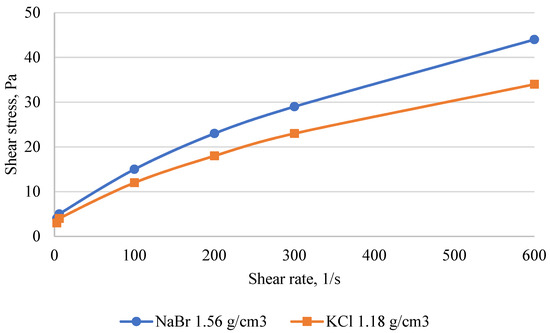
Figure 1.
Rheological curves of the created drilling fluids.
After the samples with appropriate practical rheological characteristics were created, experiments to study the thermostability of the solutions (third stage of the research) were carried out. The results of these investigations are shown in Figure 2, Figure 3, Figure 4 and Figure 5. Although biopolymers were used, the thermal stability was acceptable.
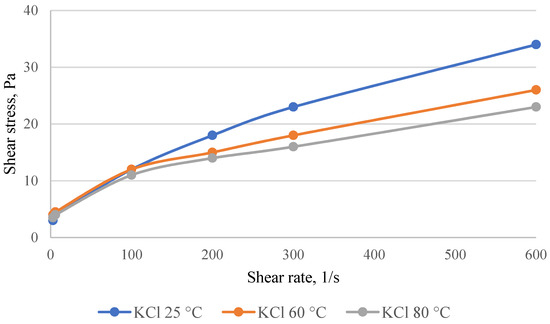
Figure 2.
Rheological curves of KCl-based mud at different temperatures.
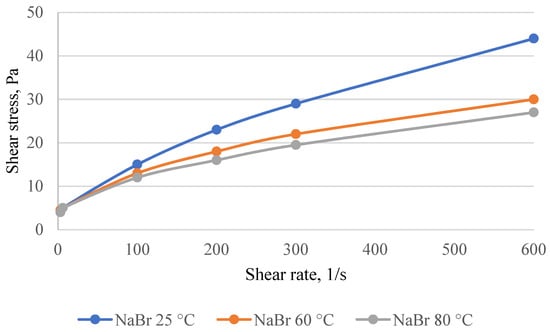
Figure 3.
Rheological curves of NaBr-based mud at different temperatures.
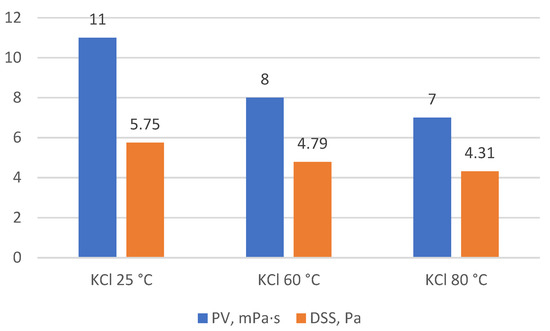
Figure 4.
Plastic viscosity (PV) and dynamic shear stress (DSS) of KCl-based drilling mud at different temperatures.
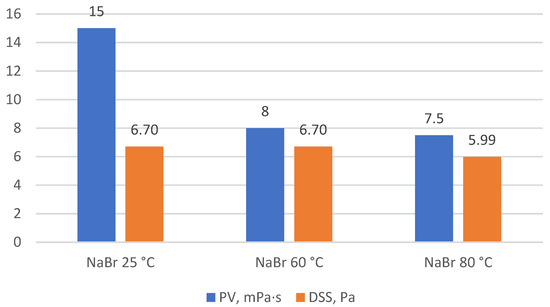
Figure 5.
Plastic viscosity (PV) and dynamic shear stress (DSS) of NaBr-based drilling mud at different temperatures.
The results for the simulation of temperature distribution for the drilling muds in the annular space are shown in Figure 6. To simulate temperature change, the following conditions were set: initial temperature of the fluid was 40 °C and formation temperature was 80 °C.
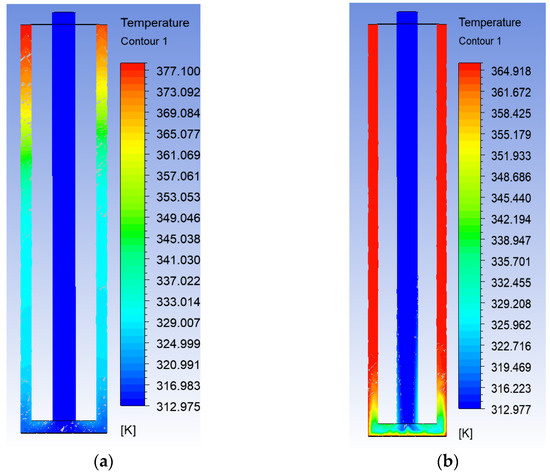
Figure 6.
Temperature distribution for the KCl-based drilling mud with density of 1.18 g/cm3 (a) and NaBr-based drilling mud with density of 1.56 g/cm3 (b) in the annular space of the well.
4. Discussion
Changes in the rheology of the drilling fluids with increasing temperature are clearly visible. The decrease in plastic viscosity can be attributed to the fact that increasing temperature causes the salt to dissolve in the dispersion medium, but it can also be attributed to the fact that a small portion of the inorganic salt may have crystallized during the time the mud has cooled. However, while reducing PV will not adversely affect the process of drilling an oil well, reducing DSS affects the carrying capacity of the mud. It is worth noting that the change is insignificant: about 10% when moving from 60 to 80 °C. The recommended DSS value, according to the literature review, should not be less than 4 Pa. This condition is fulfilled for both solutions. At the same time, the PV of the drilling fluid ranges from 9 to 15 mPa·s, which can be considered a satisfactory result considering the density, especially for the NaBr-based fluid [5,20,37].
A comparison of the results for the thermal stability of the KCl- and NaBr-based muds shows that, although the fluids contain regular starch, they do not show any degradation and, on the contrary, have greater resistance to high temperature. This can be explained by the following factors. The change in plastic viscosity by almost twofold is explained by the fact that sodium bromide starts to crystallize at a given temperature. In spite of that, the DSS remained practically unchanged, which is a sign of stable rheological parameters. Due to the fact that the basic parameters do not change during heating, the drilling process in deep wells will be efficient and safe [18,38,39].
Simulation of the temperature distribution in ANSYS (Figure 6) showed the thermal changes in the drilling fluids occurring at the nozzles of the bit. The KCl weighted solutions with lower density heat up gradually, unlike the NaBr weighted solutions. However, the KCl solutions reach higher temperatures with a maximum of 106 °C, while the NaBr-based fluid keeps a temperature of 91 °C in the whole interval. The value and rate of such a change in temperature are attributed to the higher density of the solution.
5. Conclusions
This paper deals with the issue of weighting-agent application other than barite, which is the most common weighting agent used. Despite its prevalence in practice, barite has a number of disadvantages. This led to the idea of finding and investigating alternative solutions. Such a solution is drilling fluids based on saturated brines. These compositions can achieve a density of up to 2.3 g/cm3 without solids. Moreover, K and Na ions will inhibit clays, and this will keep the wellbore stable. In addition, the reservoir may retain its original permeability due to the absence of insoluble solids that clog pores.
The paper presents the data on the research and creation of the authors’ formulation for weighted drilling mud based on sodium bromide. The developed compositions of fluids are fully suitable for practical application. The resulting drilling mud has the necessary technological parameters, which is confirmed by theoretical investigations. These KCl- and NaBr-based muds are suitable for drilling deep wells with possible abnormally high pressure due to their density of 1.18 and 1.56 g/cm3, respectively, and their thermal stability.
Considering the practical relevance presented, it can be concluded that the proposed composition of the drilling fluid can replace widespread KCl-based compositions. Bromide-based mud has acceptable rheological parameters, whereas its density is high enough. These values show that in the process of drilling, such a solution will not increase the ECD significantly.
Further research should be directed towards studying the ECD of this fluid in different wells, as well as the possibility to reduce water loss and evaluate the inhibiting ability.
Author Contributions
Formal analysis, E.L. and V.M.; Investigation, N.A.; Methodology, E.L.; Project administration, V.M.; Software, N.A.; Supervision, E.L.; Writing—original draft, N.A.; Writing—review and editing, V.M. All authors have read and agreed to the published version of the manuscript.
Funding
This research received no external funding.
Institutional Review Board Statement
Not applicable.
Informed Consent Statement
Not applicable.
Data Availability Statement
The data presented in this study are available on request from the corresponding author. The data are not publicly available due to its storage in private networks.
Conflicts of Interest
The authors declare no conflict of interest.
Nomenclature
| DSS | Dynamic Shear Stress |
| ECD | Equivalent Circulation Density |
| OBM | Oil-Based Mud |
| PV | Plastic Viscosity |
| SSS | Static Shear Stress |
| WBM | Water-Based Mud |
Appendix A
Initial data for the simulation in ANSYS are shown in this section. Figure A1 presents the base scheme of the well design used for simulation of the mud circulation. Figure A2 gives the characteristics of the mesh used in the modelling. Figure A3 shows the interface section, which specifies the properties and parameters of the drilling mud.
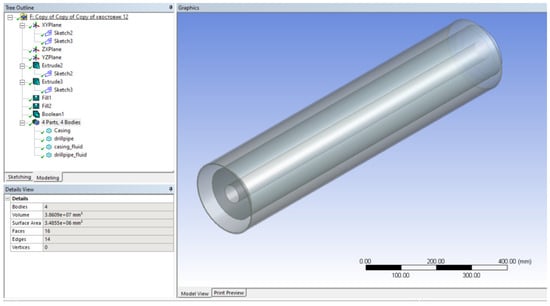
Figure A1.
Base scheme of the well design.
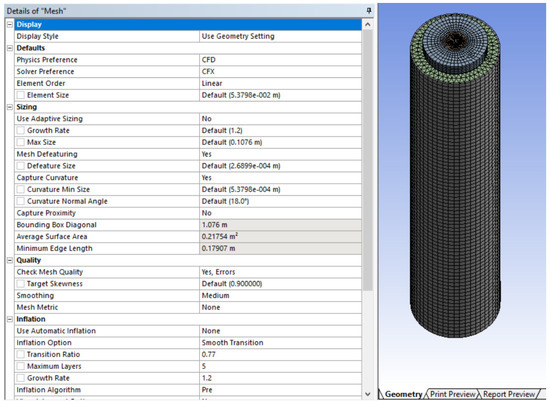
Figure A2.
Characteristics of the mesh used in the modeling.
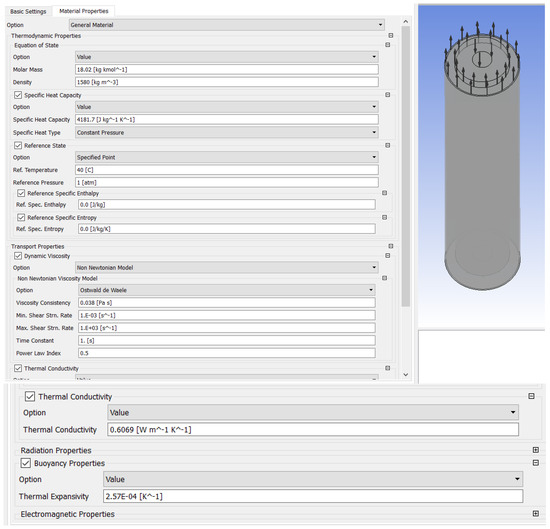
Figure A3.
Properties and parameters of the drilling mud in the well.
References
- Litvinenko, V.S.; Dvoynikov, M.V.; Trushko, V.L. Elaboration of a conceptual solution for the development of the Arctic shelf from seasonally flooded coastal areas. Int. J. Min. Sci. Technol. 2021, 30, 43–51. [Google Scholar] [CrossRef]
- Al-Salali, Y.Z.; Al-Bader, H.; Vidyasagar, D.; Manimaran, A.; Packirisamy, S.; Al-Ibrahim, A.R. Paradigm Shift in Reducing Formation Damage: Application of Potassium Formate Water Based Mud in Deep HPHT Exploratory Well. In Proceedings of the SPE Kuwait International Petroleum Conference and Exhibition, Kuwait City, Kuwait, 10–12 December 2012. [Google Scholar] [CrossRef]
- Mohamed, A.; Al-afnan, S.; Elkatatny, S.; Hussein, I. Prevention of barite sag in water-based drilling fluids by a urea-based additive for drilling deep formations. Sustainability 2020, 12, 2719. [Google Scholar] [CrossRef] [Green Version]
- Ezzat, A.M.; Gamal, M.; D’Angelo, S. High Density Brine-Based Drill-In Fluid Improved Reservoir Producibility in Gas Field Offshore Egypt. In Proceedings of the SPE North Africa Technical Conference & Exhibition, Marrakech, Morocco, 12–14 March 2008. [Google Scholar] [CrossRef]
- Long, L.; Da, Y.; Lei, L.; Zihang, Y.; Chao, H.; Cha, M.; Yuping, Y.; Xiao, L. Application of Innovative High Density High-Performance Water-Based Drilling Fluid Technology in the Efficient Development and Production of Ultra-Deep Complicated Formations in the Tian Mountain Front Block in China. In Proceedings of the Offshore Technology Conference Asia, Kuala Lumpur, Malaysia, 20–23 March 2018. [Google Scholar] [CrossRef]
- Leusheva, E.; Brovkina, N.; Morenov, V. Investigation of Non-Linear Rheological Characteristics of Barite-Free Drilling Fluids. Fluids 2021, 6, 327. [Google Scholar] [CrossRef]
- Litvinenko, V.S.; Dvoynikov, M.V. Methodology for determining the parameters of drilling mode for directional straight sections of well using screw downhole motors. J. Min. Inst. 2020, 241, 105–112. Available online: http://pmi.spmi.ru/index.php/pmi/article/view/4953 (accessed on 1 May 2022). [CrossRef]
- Fattah, K.A.; Lashin, A. Investigation of Mud Density and Weighting Materials Effect on Drilling Fluid Filter Cake Properties and Formation Damage. J. Afr. Earth Sci. 2016, 117, 345–357. [Google Scholar] [CrossRef]
- Mardashov, D.V.; Bondarenko, A.V.; Raupov, I.R. Technique for calculating technological parameters of non-Newtonian liquids injection into oil well during workover. J. Min. Inst. 2022, 1–14, (Online first). [Google Scholar] [CrossRef]
- Makhamatkhozhaev, D.R.; Yokubova FBSaidov, T.S. Drilling wells in saline sediments of JSC “Uzburneftegaz” in the Conditions of Rapoproduction. Bulatov Read. 2018, 3, 175–180. Available online: https://elibrary.ru/item.asp?id=35434341 (accessed on 1 May 2022).
- Salomatov, V.A.; Kozhayev, D.P.; Panikarovsky, E.V. Application of Inhibiting Drilling Fluid to Maintain Well Stability. Bulatov. Read. 2018, 3, 270–281. Available online: https://elibrary.ru/item.asp?id=35434371 (accessed on 1 May 2022).
- Choupani, M.A.; Tabatabaee Moradi, S.S.; Tabatabaei Nejad, S.A. Study on Attapulgite as Drilling Fluid Clay Additive in Persian Gulf Seawater. Int. J. Eng. Trans. C Asp. 2022, 35, 587–595. [Google Scholar] [CrossRef]
- Boul, P.J.; Abdulquddos, S.; Thaemlitz, C.J. High Performance Brine Viscosifiers for High Temperatures. In Proceedings of the SPE Middle East Oil & Gas Show and Conference, Manama, Bahrain, 9 March 2017. [Google Scholar]
- Zhivaeva, V.V.; Nozhkina, O.V.; Kapitonov, V.A. Development of formulations of weighted highly mineralized drilling muds and determination of their corrosive activity. Oil. Gas. Innov. 2020, 230, 29–33. Available online: https://elibrary.ru/item.asp?id=42485083 (accessed on 1 May 2022).
- Pino, R.; Abahussain, A.; Addagalla, A.; Jadhav, P. Laboratory Customizations and Field Application of Water-Based Drill-in Fluid to Enhance Well Productivity–A Case Study from the Kingdom of Saudi Arabia. In Proceedings of the SPE Kingdom of Saudi Arabia Annual Technical Symposium and Exhibition, Dammam, Saudi Arabia, 24–27 April 2017. [Google Scholar] [CrossRef]
- Yan, L.; Li, C.; Zhang, Z.; Wang, J.; Xu, X.; Sun, J.; Su, Y. Successful Application of Unique High-Density Water-Based Drilling Fluid Used in Zhaotong Shale Gas Horizontal Wells. In Proceedings of the SPE/IATMI Asia Pacific Oil & Gas Conference and Exhibition, Nusa Dua, Indonesia, 20–22 October 2015. [Google Scholar] [CrossRef]
- Babajide, A.; Adebowale, O.; Adesina, F.; Churchill, A.; Ifechukwu, M. Effects of Temperature and Pressure on Shale Cuttings Dispersion in Water Based Mud WBM Using NACL, CACL2, KCL Salts as Primary Inhibiting Agents and Polymer XCD Xanthan Gum as Secondary Inhibiting Agent. In Proceedings of the SPE Nigeria Annual International Conference and Exhibition, Lagos, Nigeria, 2–4 August 2016. [Google Scholar] [CrossRef] [Green Version]
- Ambuj, G. Identification & Development Brine-Based High Temperature-High Pressure Viscosifier Having Thermal Stability for Drilling Completion Fluids. Int. J. Eng. Sci. Comput. 2019, 9, 1–8. [Google Scholar]
- Jia, H.; Niu, C.-C.; Hu, Y.-X. The Potential Study of Ultra-High Density Heteropolysate Solid Free Brine as Well Completion Fluid for Deep Reservoir Development. J. Nat. Gas Sci. Eng. 2020, 84, 103638. [Google Scholar] [CrossRef]
- Howard, S.; Kaminski, L.; Downs, J. Xanthan Stability in Formate Brines-Formulating Non-Damaging Fluids for High Temperature Applications. In Proceedings of the SPE European Formation Damage Conference and Exhibition, Budapest, Hungary, 3–5 June 2015. [Google Scholar] [CrossRef]
- Jia, H.; Hu, Y.; Zhao, S.; Zhao, J. The Feasibility for Potassium-Based Phosphate Brines To Serve as High-Density Solid-Free Well-Completion Fluids in High-Temperature/High-Pressure Formations. SPE J. 2018, 24, 2033–2046. [Google Scholar] [CrossRef]
- Lin, F.; Chang, C.; Xu, L.; Wang, S. Study on Experimental Construction of a Novel Brine-Based Drilling Fluid for Salt-Anhydrite Formation. IOP Conf. Ser. Earth Environ. Sci. 2019, 384, 012130. [Google Scholar] [CrossRef]
- Akhmetzyanov, R.R.; Zhernakov, V.N. Simulation of the drilling mud properties at various compositions and inorganic salts concentrations. Neftyanoe Khozyaystvo-Oil Ind. 2019, 4, 33–37. [Google Scholar] [CrossRef]
- Islamov, S.R.; Bondarenko, A.V.; Mardashov, D.V. A selection of emulsifiers for preparation of invert emulsion drilling fluids. In Topical Issues of Rational Use of Natural Resources; Taylor & Francis: London, UK, 2020; pp. 487–494. [Google Scholar] [CrossRef]
- Fleming, N.; Karunakaran, M.; Hireche, S. Qualification and Implementation of Oil-Based Mud as a Cost-Effective and Low-Damaging Perforation Fluid for High-Pressure/High-Temperature Fields: Gudrun Case History. SPE Prod. Oper. 2019, 34, 429–445. [Google Scholar] [CrossRef]
- Blinov, P.A. Determining the stability of the borehole walls at drilling intervals of loosely coupled rocks considering zenith angle. J. Min. Inst. 2019, 236, 172–179. [Google Scholar] [CrossRef] [Green Version]
- Zha, W.; Galindo, K.; Zhou, H.; Deville, J.P. Thermally Stable Brine-Based Drill-In Fluids. In Proceedings of the SPE European Formation Damage Conference and Exhibition, Budapest, Hungary, 3–5 June 2015. [Google Scholar] [CrossRef]
- Al-Ansari, A.; Parra, C.; Abahussain, A.; Abuhamed, A.M.; Pino, R.; El Bialy, M.; Mohamed, H.; Lopez, C. Reservoir Drill-In Fluid Minimizes Fluid Invasion and Mitigates Differential Stuck Pipe with Improved Production Test Results. In Proceedings of the SPE Middle East Oil & Gas Show and Conference, Manama, Bahrain, 3–6 March 2017. [Google Scholar] [CrossRef]
- Li, J.; Li, Q.; Li, N.; Teng, X.; Ren, L.; Liu, H.; Guo, B.; Li, S.; Hisham, N.-E.-D.; Al-Mujalhem, M. Ultra-High Density Oil-Based Drilling Fluids Laboratory Evaluation and Applications in Ultra-HPHT Reservoir. In Proceedings of the SPE/IATMI Asia Pacific Oil & Gas Conference and Exhibition, Bali, Indonesia, 29–31 October 2019. [Google Scholar] [CrossRef]
- Palyanitsina, A.N.; Safiullina, E.U.; Byazrov, R.V.; Popodprigora, D.G.; Alekseenko, A.V. Environmentally Safe Technology to Increase Efficiency of High-Viscosity Oil Production for the Objects with Advanced Water Cut. Energies 2022, 15, 753. [Google Scholar] [CrossRef]
- Sultanbekov, R.; Beloglazov, I.; Islamov, S.; Ong, M.C. Exploring of the incompatibility of marine residual fuel: A case study using machine learning methods. Energies 2021, 14, 8422. [Google Scholar] [CrossRef]
- Han, F.; Dong, J.; Wang, X.; Tao, W.; He, X. A Study of New Low-Cost Anti-Scaling Compound Salt High-Density Solid-Free Killing Fluid. IOP Conf. Ser. : Mater. Sci. Eng. 2019, 490, 062047. [Google Scholar] [CrossRef]
- Rogachev, M.K.; Aleksandrov, A.N. Justification of a comprehensive technology for preventing the formation of asphalt-resin-paraffin deposits during the production of highlyparaffinic oil by electric submersible pumps from multiformation deposits. J. Min. Inst. 2021, 250, 596–605. [Google Scholar] [CrossRef]
- Grigoriev, B.S.; Eliseev, A.A.; Pogarskaya, T.A.; Toropovm, E.E. Mathematical modeling of rock crushing and multiphase flow of drilling fluid in well drilling. J. Min. Inst. 2019, 235, 16–23. [Google Scholar] [CrossRef]
- Syah, R.; Alizadeh, S.M.; Nurgalieva, K.S.; Grimaldo Guerrero, J.W.; Nasution, M.K.M.; Davarpanah, A.; Ramdan, D.; Metwally, A.S.M. A Laboratory Approach to Measure Enhanced Gas Recovery from a Tight Gas Reservoir during Supercritical Carbon Dioxide Injection. Sustainability 2021, 13, 11606. [Google Scholar] [CrossRef]
- de Carvalho Balaban, R.; Vidal, E.L.F.; Borges, M.R. Design of experiments to evaluate clays well inginhibition by different combinations of organic compounds and inorganic salts for application in waterbase drilling fluids. Appl. Clay Sci. 2015, 105, 124–130. [Google Scholar] [CrossRef]
- Zhou, H.; Galindo, K.A.; Zha, W. Synergistic Effect of Thermally Stable Polymers for HPHT Brine-Based Drill-in Fluids. In Proceedings of the SPE Middle East Oil & Gas Show and Conference, Manama, Bahrain, 6–9 March 2017. [Google Scholar] [CrossRef]
- Zhou, H.; Deville, J.P.; Davis, C.L. Novel High Density Brine-Based Drill-In Fluids Significantly Increased Temperature Limit for HP/HT Applications. In Proceedings of the SPE Middle East Oil & Gas Show and Conference, Manama, Bahrain, 17 March 2017. [Google Scholar] [CrossRef]
- Champeau, M.; Wei, X.; Jackson, P.; Sui, C.; Zhang, J.; Okhrimenko, A. Alternative High Density Brines. In Proceedings of the SPE Offshore Europe Conference and Exhibition, Aberdeen, UK, 4 September 2019. [Google Scholar] [CrossRef]
Publisher’s Note: MDPI stays neutral with regard to jurisdictional claims in published maps and institutional affiliations. |
© 2022 by the authors. Licensee MDPI, Basel, Switzerland. This article is an open access article distributed under the terms and conditions of the Creative Commons Attribution (CC BY) license (https://creativecommons.org/licenses/by/4.0/).